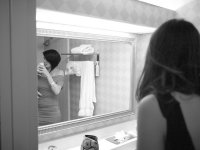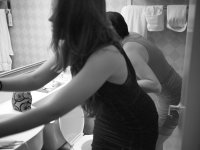Dunn
Well-known
I recently purchased an Olympus E-p2 and a Panny 20mm. I love the using the camera, but I'm having trouble with low light shots. It's mainly just in dark areas there is too much noise. It's like the camera is trying to pull out too much detail - detail that isn't even there sometimes. I would rather have deep solid blacks than noisy, grey areas.
Maybe I just haven't learned the camera yet. Can anyone tell me how to get the low light shots that I want?
Two example photos: Both shot at 1/80sec, f1.8, and ISO 640. I had the camera set to black and white, by the way. The non-dark areas of the photo look great to me: sharp and smooth
And even the shot of the reflection, the girl's hair in the mirror looks fine, but the girl on the right is all noisy.
In the other photo notice the girl's black dress.
I feel the ISO isn't even that high. I've seen some photos other people have taken at 1600 that look better.
What's up with that?
Maybe I just haven't learned the camera yet. Can anyone tell me how to get the low light shots that I want?
Two example photos: Both shot at 1/80sec, f1.8, and ISO 640. I had the camera set to black and white, by the way. The non-dark areas of the photo look great to me: sharp and smooth
And even the shot of the reflection, the girl's hair in the mirror looks fine, but the girl on the right is all noisy.
In the other photo notice the girl's black dress.
I feel the ISO isn't even that high. I've seen some photos other people have taken at 1600 that look better.
What's up with that?
Attachments
Last edited:





